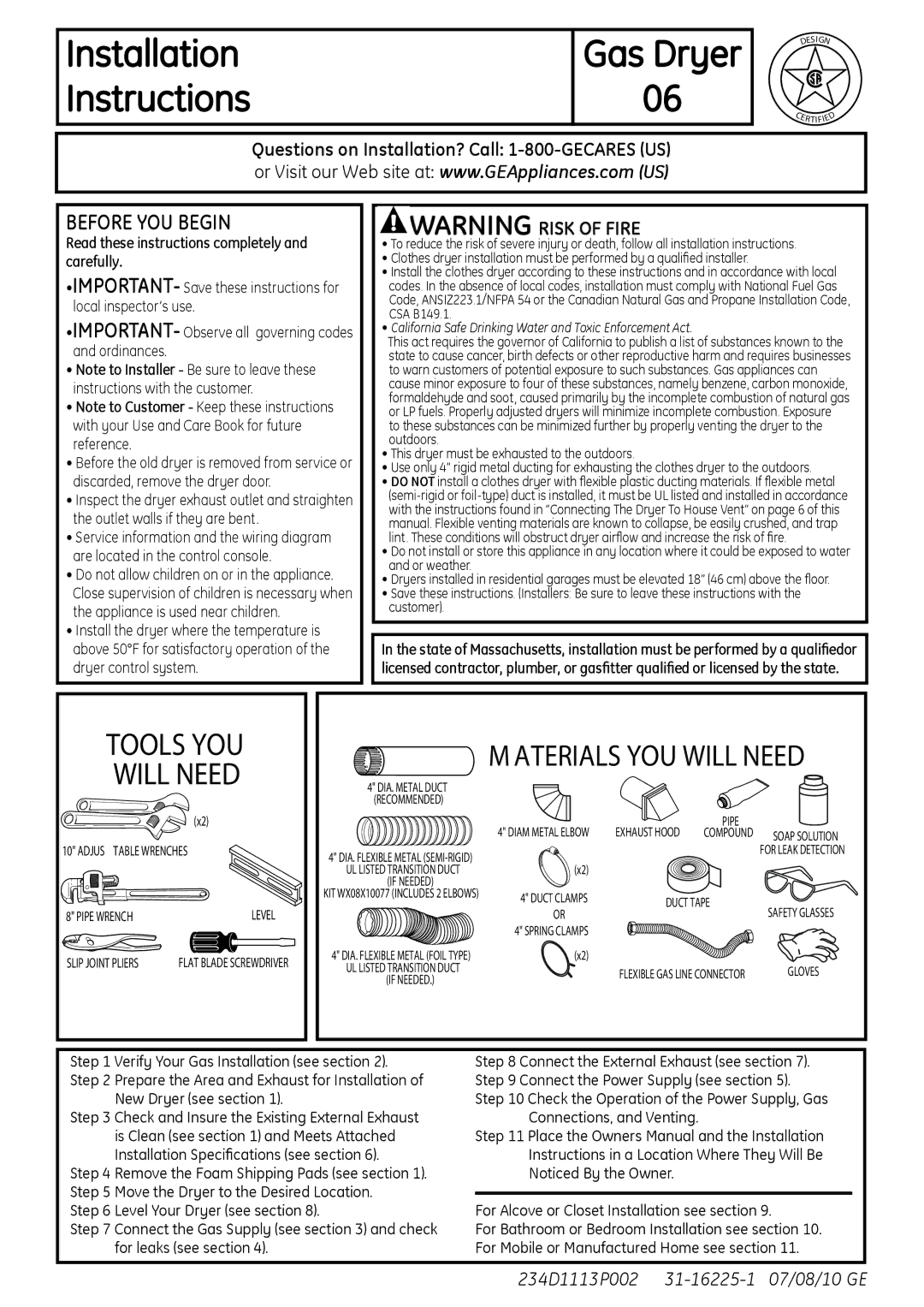
Installation | Gas Dryer |
Instructions | 06 |
| Questions on Installation? Call: |
| or Visit our Web site at: www.GEAppliances.com (US) |
DE | I |
GN | |
S |
|
C | D |
ERT IFIE | |
BEFORE YOU BEGIN
Read these instructions completely and carefully.
•IMPORTANT- Save these instructions for local inspector’s use.
•IMPORTANT- Observe all governing codes and ordinances.
•Note to Installer - Be sure to leave these instructions with the customer.
•Note to Customer - Keep these instructions with your Use and Care Book for future reference.
•Before the old dryer is removed from service or discarded, remove the dryer door.
•Inspect the dryer exhaust outlet and straighten the outlet walls if they are bent.
•Service information and the wiring diagram are located in the control console.
•Do not allow children on or in the appliance. Close supervision of children is necessary when the appliance is used near children.
•Install the dryer where the temperature is above 50°F for satisfactory operation of the dryer control system.
![]() WARNING RISK OF FIRE
WARNING RISK OF FIRE
• To reduce the risk of severe injury or death, follow all installation instructions.
• Clothes dryer installation must be performed by a qualified installer.
• Install the clothes dryer according to these instructions and in accordance with local codes. In the absence of local codes, installation must comply with National Fuel Gas Code, ANSIZ223.1/NFPA 54 or the Canadian Natural Gas and Propane Installation Code, CSA B149.1.
• California Safe Drinking Water and Toxic Enforcement Act.
This act requires the governor of California to publish a list of substances known to the state to cause cancer, birth defects or other reproductive harm and requires businesses to warn customers of potential exposure to such substances. Gas appliances can cause minor exposure to four of these substances, namely benzene, carbon monoxide, formaldehyde and soot, caused primarily by the incomplete combustion of natural gas or LP fuels. Properly adjusted dryers will minimize incomplete combustion. Exposure to these substances can be minimized further by properly venting the dryer to the outdoors.
•This dryer must be exhausted to the outdoors.
•Use only 4” rigid metal ducting for exhausting the clothes dryer to the outdoors.
•DO NOT install a clothes dryer with flexible plastic ducting materials. If flexible metal
•Do not install or store this appliance in any location where it could be exposed to water and or weather.
•Dryers installed in residential garages must be elevated 18” (46 cm) above the floor.
•Save these instructions. (Installers: Be sure to leave these instructions with the customer).
In the state of Massachusetts, installation must be performed by a qualifiedor licensed contractor, plumber, or gasfitter qualified or licensed by the state.
TOOLS YOU | |
WILL NEED | |
| (x2) |
10" ADJUS TABLE WRENCHES | |
8" PIPE WRENCH | LEVEL |
SLIP JOINT PLIERS | FLAT BLADE SCREWDRIVER |

 M ATERIALS YOU WILL NEED
M ATERIALS YOU WILL NEED
4" DIA. METAL DUCT (RECOMMENDED)
| 4" DIAM METAL ELBOW | EXHAUST HOOD | PIPE |
| |
| COMPOUND | SOAP SOLUTION | |||
4" DIA. FLEXIBLE METAL |
|
|
|
| FOR LEAK DETECTION |
| (x2) |
|
|
| |
UL LISTED TRANSITION DUCT |
|
|
|
| |
(IF NEEDED) |
|
|
|
|
|
KIT WX08X10077 (INCLUDES 2 ELBOWS) | 4" DUCT CLAMPS | DUCT TAPE |
| ||
| SAFETY GLASSES | ||||
| OR |
| |||
|
|
|
| ||
| 4" SPRING CLAMPS |
|
|
| |
4" DIA. FLEXIBLE METAL (FOIL TYPE) |
| (x2) |
|
|
|
UL LISTED TRANSITION DUCT |
|
| FLEXIBLE GAS LINE CONNECTOR | GLOVES | |
(IF NEEDED.) |
|
|
|
|
|
Step 1 | Verify Your Gas Installation (see section 2). | Step 8 Connect the External Exhaust (see section 7). | |
Step 2 | Prepare the Area and Exhaust for Installation of | Step 9 Connect the Power Supply (see section 5). | |
| New Dryer (see section 1). | Step 10 Check the Operation of the Power Supply, Gas | |
Step 3 | Check and Insure the Existing External Exhaust | Connections, and Venting. | |
| is Clean (see section 1) and Meets Attached | Step 11 Place the Owners Manual and the Installation | |
| Installation Specifications (see section 6). | Instructions in a Location Where They Will Be | |
Step 4 Remove the Foam Shipping Pads (see section 1). | Noticed By the Owner. | ||
Step 5 Move the Dryer to the Desired Location. |
|
| |
|
| ||
Step 6 | Level Your Dryer (see section 8). | For Alcove or Closet Installation see section 9. | |
Step 7 Connect the Gas Supply (see section 3) and check | For Bathroom or Bedroom Installation see section 10. | ||
| for leaks (see section 4). | For Mobile or Manufactured Home see section 11. | |
|
|
|
|
234D1113P002
